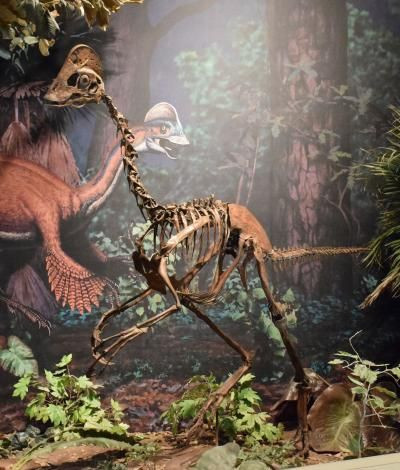‘Chicken From Hell’ Dinosaur Species Discovered, ‘Anzu Wyliei’ Is ‘Weirder’ Than Imagined [PHOTO]

A new dinosaur species belonging to a genus that has been shrouded in mystery has been discovered.
Named Anzu wyliei, the 11-foot dinosaur has been nicknamed the “chicken from hell” after its unusual outward appearance. Paleontologists discovered the new species after analyzing three specimens that collectively created an almost entire skeleton of the newfound dinosaur.
"Anzu is far and away the most complete caenagnathid that has ever been discovered,” Dr. Matthew Lamanna of Carnegie Museum of Natural History in Pittsburgh said in a statement referring to a family of bird-like dinosaurs from the Late Cretaceous of North America and Asia. “After nearly a century of searching, we paleontologists finally have the fossils to show what these creatures looked like from virtually head to toe. And in almost every way, they're even weirder than we imagined."
The findings, published in the journal PLOS ONE, describe the how the Anzu can help scientists understand the anatomy and evolutionary history of the Caenagnathidae as a whole. For instance, the study confirmed the hypothesis that the 1.5-ton Gigantoraptor belonged to the Caenagnathidae group rather than the Oviraptoridae as previously held.
"For nearly a hundred years, we paleontologists knew almost nothing about these dinosaurs," Lamanna said. "Now, thanks to Anzu, we're finally starting to figure them out."
The Anzu was found from fossil skeletons excavated from roughly 66 million-year-old rocks in the Hell Creek Formation in North and South Dakota. Rather than resembling a “typical” theropod like a T. rex, the Anzu would have had a toothless beak with a tall rounded crest on the top of its head, similar to what a modern ostrich has. Close relatives to the Anzu suggest it would have had feathers.
"We jokingly call this thing the 'Chicken from Hell,' and I think that's pretty appropriate. So we named it after Anzu, a bird-like demon in ancient mythology," Lamanna said.
While the Anzu is a relatively new discovery, the Caenagnathidae group of dinosaurs has been known for more than 100 years ago. First evidence of the group was identified in 1924 when paleontologist Charles Whitney Gilmore analyzed fossil hands found in 74-million-year-old rocks unearthed in Alberta, Canada. At the time, the species was named Chirostenotes pergracilis. In 1940, another dinosaur named Caenagnathus collinsi was identified. Later, both of these species were found to belong to the Caenagnathidae group.
The nearly complete skeleton of the Anzu, a replica of which is on public display at the Carnegie Museum of Natural History in Pittsburgh, Penn., has shed light on the dinosaur’s environment, diet and habitat preferences. Lamanna posits the Anzu was an omnivore that most likely lived on floodplains. The skeletons suggest the dinosaur was not immune from danger. Two of the three skeletons showed signs of injuries including a broken rib and arthritic toe bone.
"These animals were clearly able to survive quite a bit of trauma, as two of the specimens show signs of semi-healed damage,” Dr. Emma Schachner of the University of Utah in Salt Lake City said. “Whether these injuries were the result of combat between two individuals or an attack by a larger predator remains a mystery."
© Copyright IBTimes 2024. All rights reserved.






















